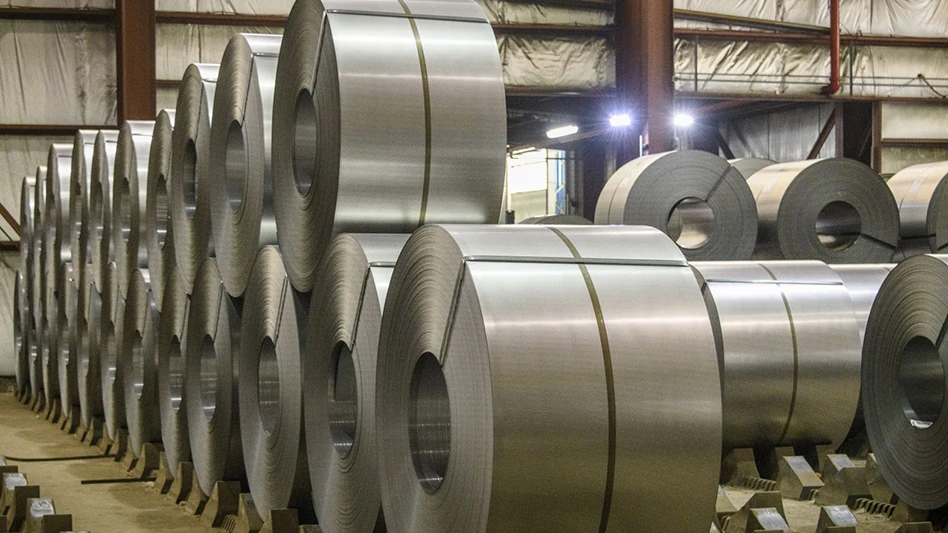Overall, price and demand for secondary plastics remains strong, particularly among domestic consumers. This strength is despite declining prices for prime material, according to sources.
Candace Rutherford of United Plastics Recycling, Montgomery, Ala., says engineering grade regrind has been especially difficult to find recently in light of the high demand.
“Commodity grades are still going strong, including most polyethylenes (PEs) and all types of polypropylene (PP),” she adds. “There is a large gap between primary and secondary markets, which I think will help to keep the secondary markets stable. They jumped some but not as much incrementally as the primary markets.”
MINDING THE GAP
Rutherford characterizes the current gap in pricing between prime and recycled plastics as the largest she has seen. “Even if virgin drops, I think we will still be able to continue to ask for today’s pricing on recycled,” she says, adding that during the last upswing in the prime market, many consumers began using recycled material and were pleased with its performance. She says this continued demand will put pressure on the limited supply of recycled material available.
However, Neil Gloger, CEO and founder of InterGroup International, Euclid, Ohio, says he’s seen the gap narrow between virgin material and some high-end grades of recycled plastics recently.
He says as virgin pricing further escalated beginning in April and peaked in early June, scrap pricing followed. “But, even on a percentage basis, the spread became narrower for the higher grades of scrap,” Gloger adds. “It’s the typical demand-driven way that it works. Anything that can replace prime shot up in price at a faster rate than prime shot up.”
David Kaplan, CEO of Maine Plastics, Zion, Ill., says a loose correlation exists between the prime and secondary plastics pricing. “One typically follows the other in a matter of weeks to months.”
But, he adds, in a softening market, it is less apparent. “While many people price their materials based on virgin, in a declining market, because most indicators are 30 days behind and secondary markets lag a little bit behind that, you can get into trouble,” Kaplan says.
Kaplan points to the market collapse seen at the end of 2008 as an example. “In a rapidly declining market, as in 2008, a lot of people were upside-down because they were paying more than double what they could get for [material] because the indicators still said that everything was great.”
While domestic demand for secondary plastics remains strong, export demand has softened, according to sources. The typical seasonal slowdown related to the automotive and housing markets also are expected to dampen domestic demand as summer advances.
DECODING DEMAND
| GOALS AND ACCOMPLISHMENTS |
| Companies in the European PVC industry who have been part of the Vinyl 2010 recycling effort released a final progress report on that effort in June. Their claim: “Vinyl 2010 has succeeded in meeting or exceeding all of the targets set by the industry in 2000.” Vinyl 2010 is described as a 10-year voluntary commitment “to enhance the sustainable production and use of PVC (polyvinyl chloride).” In a news release announcing the progress report, Vinyl 2010’s backers state, “In 1999 there was no infrastructure for recycling of PVC in Europe and it was dismissed by many as an ‘unrecyclable’ material. Today, the audit results show that in the last year alone 260,800 metric tons of unregulated post-consumer PVC [scrap was] recycled by Vinyl 2010’s network of PVC recyclers across Europe—well beyond the initial goal of recycling an additional 200,000 metric tons on an annual basis by 2010.” Josef Ertl, Vinyl 2010 chairman states, “Vinyl 2010 has been a clear success and is a perfect example of industry self-regulation working in practice. It is no exaggeration to say that it has helped to revolutionize the PVC value chain in Europe.” He also urged more companies to get involved with PVC recycling and the extension of the Vinyl 2019 program. VinylPlus, as the new voluntary commitment will be called, was scheduled to be formally unveiled before the end of June 2011. |
While domestic demand for secondary plastics remains strong, Kaplan describes the export market, particularly to China, as “tenuous.” He attributes the situation to higher Chinese import duties, which have caused Chinese consumers to offer less for secondary material.
“Engineering grades are never as volatile as commodity grades.”
– David Kaplan, Maine Plastics
Also contributing to the decline, he says, are rising wages in China, which make lower-end secondary plastics that require additional hand sorting less desirable. As a result, Maine Plastics has had to look to other overseas markets, such as Vietnam.
Gloger attributes declining demand from China to its government’s efforts to slow inflation and to tighten banking requirements.
He also has heard that the Indian market has softened, though he says he has yet to see an effect on price or demand in his business.
Rutherford attributes the decline in overseas demand to economic development and growing recycling infrastructure in countries such as China and India. “It seems as more people overseas have disposable income, they are spending domestically and the process [scrap] stays over there, thus decreasing the need to source raw material from other places,” she says.
InterGroup International sees the strongest demand currently for rigid PVC (polyvinyl chloride) and PP (polypropylene), Gloger says.
“The export market is firm but it is not crazy, meaning that we are able to move all of the material that we offer out on the market at a fair price but we are not getting 10 calls a day for export-grade materials,” he adds.
Gloger characterizes domestic demand for rigid PVC and PP as being “exceptional.”
PVC markets softened as of early June, however. Gloger attributes softening prices to the growth in prime material, as chemicals manufactures, such as Atlanta-based Georgia Gulf Corp., come back online after declaring force majeure earlier this year in response to reduced ethylene supplies. This action combined with export demand “produced stunning gains in pricing for PVC as well as polypropylene,” Gloger says.
Despite this softening, Gloger describes recycled PVC pricing and demand as “still extremely strong.”
Maine Plastics’ Kaplan says commodity grades have softened somewhat while engineering grades have held steady. “Engineering grades are never as volatile as commodity grades,” he adds.
Seasonal factors also play a role in secondary plastics markets, with demand and pricing generally declining in the summer as automotive suppliers, for instance, take downtime to retool their lines for the coming model year. “June, July and August, with shutdowns, prices do typically drop,” he says. “Typically in the fall, prices will increase as manufacturers look to gear up for the winter months, but because of other factors it may not be as pronounced,” Kaplan adds, citing the decline in exports to China as a contributing factor.
“Commodity grades are still going strong, including most polyethylenes and all types of polypropylene.”
– Candace Rutherford, United Plastics Recycling
These seasonal factors also affect scrap generation, but for now reprocessors characterize the flow of incoming material as good to stable.
WANTING MORE
Kaplan describes generation of scrap material as good. “As manufacturing is sustained, generation of scrap is sustained,” he says, adding that given this situation, less material is available on the market than he would expect. He attributes this to the increasing number of manufacturers who are attempting to re-use their manufacturing scrap in a closed loop, either by employing reprocessors in toll processing arrangements or by recycling in house.
Rutherford says generation related to the automotive industry is slower than is typical. However, she adds, generation from other consumer goods manufacturers has been steady.
Recycled feedstock generally remains in short supply, Rutherford says, which has helped to drive up pricing for the material in the first half of 2011.

Explore the July 2011 Issue
Check out more from this issue and find your next story to read.
Latest from Recycling Today
- Fitch Ratings sees reasons for steel optimism in 2025
- P+PB adds new board members
- BlueScope, BHP & Rio Tinto select site for electric smelting furnace pilot plant
- Magnomer joins Canada Plastics Pact
- Out of touch with reality
- Electra names new CFO
- WM of Pennsylvania awarded RNG vehicle funding
- Nucor receives West Virginia funding assist





